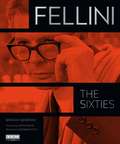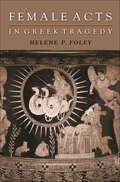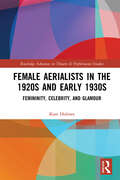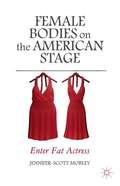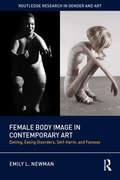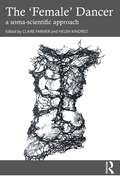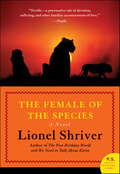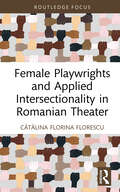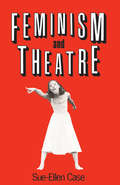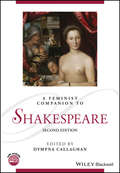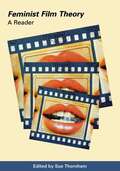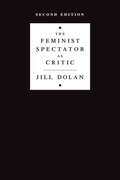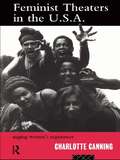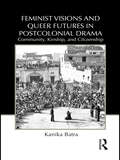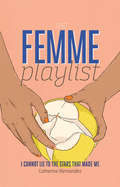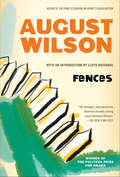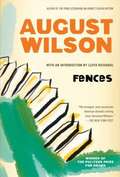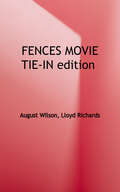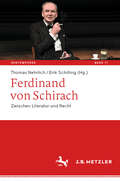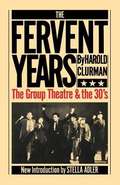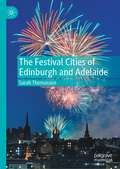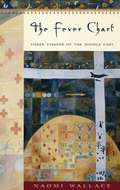- Table View
- List View
Fellini: The Sixties (Turner Classic Movies)
by Manoah Bowman Foreword by Anita Ekberg Afterword by Barbara Steele Photographic Editor David Wills Designed by Stephen SchmidtStyle. Beauty. Passion. Vision. These are just a few of the words often used to describe the films of the single most celebrated director in Italy, and one of the most important directors the world has ever known--Federico Fellini. Fifty years since their initial releases, his films of the 1960’s still inspire, shock and delight. More than just encapsulating the 1960’s, these films also helped define the style of the decade. With a staggering twelve Academy Award nominations between his four feature films during this period, Fellini reached the heights of fame, film artistry, and worldwide prominence. Studied, analyzed and re-released over the years, these films continue to amaze each new generation that discovers them. Their impeccable style makes them timeless. Their images make them unforgettable. Their passion brings them to life. And their singular vision makes them unique in all of cinema. Fellini: The Sixties is a stunning photographic journey through the director’s most iconic classics: La Dolce Vita, 8½, Juliet of the Spirits, and Fellini Satyricon. Carefully selected imagery from the Independent Visions photographic archive, many published here for the first time, illuminate these films as they have never been seen before, and reveal fascinating details of the director’s working style and ebullient personality. With more than 150 photographs struck from original negatives, these images spring to life from the page with the depth and quality of the films themselves. Complemented with insightful essays from contemporary writers, Fellini: The Sixties is a true testament to the man and his work, a remarkable compendium to the legendary filmmaker’s greatest achievements.
Female Acts in Greek Tragedy (Martin Classical Lectures #15)
by Helene P. FoleyAlthough Classical Athenian ideology did not permit women to exercise legal, economic, and social autonomy, the tragedies of Aeschylus, Sophocles, and Euripides often represent them as influential social and moral forces in their own right. Scholars have struggled to explain this seeming contradiction. Helene Foley shows how Greek tragedy uses gender relations to explore specific issues in the development of the social, political, and intellectual life in the polis. She investigates three central and problematic areas in which tragic heroines act independently of men: death ritual and lamentation, marriage, and the making of significant ethical choices. Her anthropological approach, together with her literary analysis, allows for an unusually rich context in which to understand gender relations in ancient Greece. This book examines, for example, the tragic response to legislation regulating family life that may have begun as early as the sixth century. It also draws upon contemporary studies of virtue ethics and upon feminist reconsiderations of the Western ethical tradition. Foley maintains that by viewing public issues through the lens of the family, tragedy asks whether public and private morality can operate on the same terms. Moreover, the plays use women to represent significant moral alternatives. Tragedy thus exploits, reinforces, and questions cultural clichés about women and gender in a fashion that resonates with contemporary Athenian social and political issues.
Female Aerialists in the 1920s and Early 1930s: Femininity, Celebrity, and Glamour (Routledge Advances in Theatre & Performance Studies)
by Kate HolmesFemale solo aerialists of the 1920s and early 1930s were internationally popular performers in the largest live performance mass entertainment of the period in the UK and USA. Yet these aerialists and this period in circus history have been largely forgotten despite the iconic image of ‘the’ female aerialist still flaring in the popular imagination. Kate Holmes uses insights gained as a practitioner to reconstruct in detail the British and American performances and public personae of key stars such as Lillian Leitzel, Luisita Leers, and the Flying Codonas, revealing what is performed and implicit in today’s practice. Using a wealth of original sources, this book considers the forgotten stars whose legacy of the cultural image of the female aerialist echoes. Locating performers within wider cultural histories of sport, glamour, and gender, this book asks important questions about their stardom, including: Why were female aerialists so alluring when their muscularity challenged conservative ideals of femininity and how did they participate in change? What was it about their movements and the spaces they performed in that activated such strong audience responses? This book is vital reading for students and practitioners of aerial performance, circus, gender, popular performance, and performance studies.
Female Bodies on the American
by Jennifer-Scott MobleyThe fat female body is a unique construction in American culture that has been understood in various ways during the twentieth and early twenty-first centuries. Analyzing post-WWII stage and screen performances, Mobley argues that the fat actress's body signals myriad cultural assumptions and suggests new ways of reading the body in performance.
Female Body Image in Contemporary Art: Dieting, Eating Disorders, Self-Harm, and Fatness (Routledge Research in Gender and Art)
by Emily L. NewmanNumerous contemporary artists, particularly female artists, have chosen to examine the idealization of the female body. In this crucial book, Emily L. Newman focuses on a number of key themes including obesity, anorexia, bulimia, dieting, self-harm, and female body image. Many artists utilize their own bodies in their work, and in the act of trying to critique the diet industry, they also often become complicit, as they strive to lose weight themselves. Making art and engaging eating disorder communities (in real life and online) often work to perpetuate the illnesses of themselves or others. A core group of artists has worked to show bodies that are outside the norm, paralleling the rise of fat activism in the 1990s and 2000s. Interwoven throughout this inclusive study are related interdisciplinary concerns including sociology, popular culture, and feminism.
The 'Female' Dancer: a soma-scientific approach
by Claire Farmer Helen KindredThe 'Female' Dancer aims to question dancers’ relationships with ‘female’ through the examination and understandings of biological, anatomical, scientific, and self-social identity. The volume gathers voices of dance scientists, dance scholars, somatic practitioners, and dance artist-educators, to discuss some of the complexities of identities, assumptions and perceptions of a female dancing body in an intersectional and practically focused manner.The book weaves a journey between scientific and somatic approaches to dance and to dancing. Part I: 'Bodily Knowledge' explores body image, hormones and puberty, and discussions around somatic responses to the concept of the gaze. Part II: 'Moving through Change', continues to look at strength, musculature, and female fragility, with chapters interrogating practice around strength training, the dancer as an athlete, the role of fascia, the pelvic floor, pregnancy and post-partum experiences and eco-somatic perceptions of feminine. In 'Taking up Space', Part III, chapters focus on social-cultural and political experiences of females dancing, leadership, and longevity in dance. Part IV: 'Embodied Wisdom' looks at reflections of the Self, physiological, social and cultural perspectives of dancing through life, with life’s seasons from an embodied approach.Drawing together lived experiences of dancers in relationship with scientific research, this book is ideal for undergraduate students of dance, dance artists, and researchers, as well as providing dancers, dance teachers, healthcare practitioners, company managers and those in dance leadership roles with valuable information on how to support female identifying dancers through training and beyond.
The Female of the Species: A Novel
by Lionel Shriver“Shriver’s debut is a 'literary' novel without an iota of pretentiousness. It reads with the grace of a well-written spy story, but conveys some of its author’s early wisdom about what our humanity both demands of and grants us.” —Washington PostThe first novel by the New York Times bestselling author Lionel Shriver, The Female of the Species is the exotic and chilling story of a highly independent and successful woman’s late-life romantic education, in all its ecstasy and desperationStill unattached and childless at fifty-nine, world-renowned anthropologist Gray Kaiser is seemingly invincible—and untouchable. Returning to make a documentary at the site of her first great triumph in Kenya, she is accompanied by her faithful middle-aged assistant, Errol McEchern, who has loved her for years in silence. When sexy young graduate assistant Raphael Sarasola arrives on the scene, Gray is captivated and falls hopelessly in love—before an amazed and injured Errol's eyes. As he follows the progress of their affair with jealous fascination, Errol watches helplessly from the sidelines as a proud and fierce woman is reduced to miserable dependence through subtle, cruel, and calculating manipulation.
Female Playwrights and Applied Intersectionality in Romanian Theater (Routledge Advances in Theatre & Performance Studies)
by Cătălina Florina FlorescuIn this collection, the author focuses on several contemporary Romanian female playwrights with residencies in Europe and the U.S.: Alexandra Badea, Carmen Francesca Banciu, Alexa Băcanu, Ana Sorina Corneanu, Mihaela Drăgan, Dr. Cătălina Florina Florescu, Dr. Mihaela Michailov, Dr. Domnica Rădulescu, Saviana Stănescu, and Dr. Elise Wilk. In their bold works, written by female playwrights who are academics, activists, and performers, we are invited to discover variations in the modus operandi of the dramatic language itself from metaphorical to matter-of-fact approaches. Furthermore, while all these playwrights speak Romanian, they also think and operate in various other languages, such as Romani, German, French, Italian, and American English. This book facilitates scholars and students to discover contemporary issues related to Romanian society as presented heavily from a feminine angle and to reveal intersectional issues as seen and applied to dramatic characters in a post-communist country from some authors who experienced communism firsthand. The book is also an invitation to reinvent how we teach dramatic literature by offering 20 interactive, exploratory activities.
Feminism and Theatre
by Sue-Ellen CaseThis classic study is both an introduction to, and an overview of, the relationship between feminism and theatre.
Feminist Comedy: Women Playwrights of London (EARLY MODERN FEMINISMS)
by Willow WhiteFeminist Comedy: Women Playwrights of London identifies the eighteenth-century comedic stage as a key site of feminist critique, practice, and experimentation. While the history of feminism and comedy is undeniably vexed, by focusing on five women playwrights of the latter half of the eighteenth century--Catherine Clive, Frances Brooke, Frances Burney, Hannah Cowley, and Elizabeth Inchbald--this book demonstrates that stage comedy was crucial to these women’s professional success in a male-dominated industry and reveals a unifying thread of feminist critique that connects their works. Though male detractors denied women’s comic ability throughout the era, eighteenth-century women playwrights were on the cutting edge of comedy and their work had important feminist influence that can be traced to today’s stages and screens.
A Feminist Companion to Shakespeare
by Dympna CallaghanThe question is not whether Shakespeare studies needs feminism, but whether feminism needs Shakespeare. This is the explicitly political approach taken in the dynamic and newly updated edition of A Feminist Companion to Shakespeare. Provides the definitive feminist statement on Shakespeare for the 21st century Updates address some of the newest theatrical andcreative engagements with Shakespeare, offering fresh insights into Shakespeare's plays and poems, and gender dynamics in early modern England Contributors come from across the feminist generations and from various stages in their careers to address what is new in the field in terms of historical and textual discovery Explores issues vital to feminist inquiry, including race, sexuality, the body, queer politics, social economies, religion, and capitalism In addition to highlighting changes, it draws attention to the strong continuities of scholarship in this field over the course of the history of feminist criticism of Shakespeare The previous edition was a recipient of a Choice Outstanding Academic Title award; this second edition maintains its coverage and range, and bringsthe scholarship right up to the present day
Feminist Film Theory: A Reader
by Sue ThornhamFor the past twenty-five years, cinema has been a vital terrain on which feminist debates about culture, representation, and identity have been fought. This anthology charts the history of those debates, bringing together the key, classic essays in feminist film theory. <p><p> This book maps the impact of major theoretical developments on this growing field-from structuralism and psychoanalysis in the 1970s, to post-colonial theory, queer theory, and postmodernism in the 1990s. Covering a wide range of topics, including oppressive images, "woman" as fetishized object of desire, female spectatorship, and the cinematic pleasures of black women and lesbian women, the book is an indispensable reference for scholars and students in the field.
The Feminist Spectator as Critic (Second Edition)
by Jill DolanThe Feminist Spectator as Critic broke new ground as one of the pioneering books on feminist spectatorship, encouraging resistant readings to generate feminist meanings in performance. Approaching live spectatorship through a range of interdisciplinary methods, the book has been foundational in theater studies, performance studies, and gender/sexuality/women's studies. This updated and enlarged second edition celebrates the book's twenty-fifth anniversary with a substantial new introduction and up-to-the-moment bibliography, detailing the progress to date in gender equity in theater and the arts, and suggesting how far we have yet to go.
Feminist Theatre Practice: A Handbook
by Elaine AstonFeminist Theatre Practice: A Handbook is a helpful, practical guide to theatre-making which explores the different ways of representing gender. Best-selling author, Elaine Aston, takes the reader through the various stages of making feminist theatre- from warming up, through workshopped exploration, to performance - this volume is organised into three clear and instructive parts: * Women in the Workshop * Dramatic Texts, Feminist Contexts * Gender and Devising Projects. Orientated around the classroom/workshop, Handbook of Feminist Theatre Practice encompasses the main elements of feminist theatre, both practical or theoretical.
Feminist Theatres in the USA: Staging Women's Experience (Gender in Performance)
by Charlotte CanningFeminist Theaters in the USA is a fresh, informative portrait of a key era in feminist and theater history It is vital reading for feminist students, theater historians and theater practitioners. Their continued movement forward will be challenged and enriched by this timely look back at the trials and accomplishments of their predecessors. Canning interviews over thirty women who took part in the dynamic feminist theater of the 1970s and 1980s. They provide first-hand accounts of the excitement, struggles and innovations which formed their experience. From this foundation Cannning constructs a compelling combination of historical survey, critique and celebration which explores: * The history of the groups and their formation * The politics which shaped their work * Their methods and creative processes * The productions they brought to the stage * The reception from critics and audiences
Feminist Visions and Queer Futures in Postcolonial Drama: Community, Kinship, and Citizenship (Routledge Advances In Theatre And Performance Studies #17)
by Kanika BatraIn this timely study, Batra examines contemporary drama from India, Jamaica, and Nigeria in conjunction with feminist and incipient queer movements in these countries. Postcolonial drama, Batra contends, furthers the struggle for gender justice in both these movements by contesting the idea of the heterosexual, middle class, wage-earning male as the model citizen and by suggesting alternative conceptions of citizenship premised on working-class sexual identities. Further, Batra considers the possibility of Indian, Jamaican, and Nigerian drama generating a discourse on a rights-bearing conception of citizenship that derives from representations of non-biological, non-generational forms of kinship. Her study is one of the first to examine the ways in which postcolonial dramatists are creating the possibility of a dialogue between cultural activism, women’s movements, and an emerging discourse on queer sexualities.
The Femme Playlist & I Cannot Lie to the Stars That Made Me
by Catherine HernandezFrom masturbation to motherhood, body shaming to burlesque, Catherine Hernandez reveals the reality of living as a queer woman of colour. Set to the music of her life, The Femme Playlist shows what it’s like to be sexy and proud, slutty and loud, queer and brown. I Cannot Lie to the Stars That Made Me is an around-the-campfire guide to mourning and healing for women of colour, written after Hernandez and her daughter left an abusive relationship. As a group of women share their stories around a campfire, they pray for each other and give as much strength as their bodies will allow.
Fences: A Play
by August WilsonFrom legendary playwright August Wilson comes the powerful, stunning dramatic bestseller that won him critical acclaim, including the Tony Award for Best Play and the Pulitzer Prize.Troy Maxson is a strong man, a hard man. He has had to be to survive. Troy Maxson has gone through life in an America where to be proud and black is to face pressures that could crush a man, body and soul. But the 1950s are yielding to the new spirit of liberation in the 1960s, a spirit that is changing the world Troy Maxson has learned to deal with the only way he can, a spirit that is making him a stranger, angry and afraid, in a world he never knew and to a wife and son he understands less and less. This is a modern classic, a book that deals with the impossibly difficult themes of race in America, set during the Civil Rights Movement of the 1950s and 60s. Now an Academy Award-winning film directed by and starring Denzel Washington, along with Academy Award and Golden Globe winner Viola Davis.
Fences
by August Wilson Lloyd RichardsThe 1987 Winner of the Pulitzer Prize for Drama From August Wilson, author of The Piano Lesson and the 1984-85 Broadway season's best play, Ma Rainey's Black Bottom, is another powerful, stunning dramatic work that has won him numerous critical acclaim including the 1987 Tony Award for Best Play and the Pulitzer Prize. The protagonist of Fences (part of Wilson's ten-part "Pittsburgh Cycle" plays), Troy Maxson, is a strong man, a hard man. He has had to be to survive Troy Maxson has gone through life in an America where to be proud and black is to face pressures that could crush a man, body and soul. But the1950s are yielding to the new spirit of liberation in the 1960s. . . a spirit that is changing the world Troy Maxson has learned to deal with the only way he can. . . a spirit that is making him a stranger, angry and afraid, in a world he never knew and to a wife and son he understands less and less. . .
Fences (movie Tie-in)
by August WilsonFrom legendary playwright August Wilson comes the powerful, stunning dramatic bestseller that won him critical acclaim, including the Tony Award for Best Play and the Pulitzer Prize. Troy Maxson is a strong man, a hard man. He has had to be to survive. Troy Maxson has gone through life in an America where to be proud and black is to face pressures that could crush a man, body and soul. But the 1950s are yielding to the new spirit of liberation in the 1960s, a spirit that is changing the world Troy Maxson has learned to deal with the only way he can, a spirit that is making him a stranger, angry and afraid, in a world he never knew and to a wife and son he understands less and less. This is a modern classic, a book that deals with the impossibly difficult themes of race in America, set during the Civil Rights Movement of the 1950s and 60s. Now an Academy Award-winning film directed by and starring Denzel Washington, along with Academy Award and Golden Globe winner Viola Davis.
Ferdinand von Schirach: Zwischen Literatur und Recht (Kontemporär. Schriften zur deutschsprachigen Gegenwartsliteratur #17)
by Erik Schilling Thomas NehrlichFerdinand von Schirach war lange Strafverteidiger, bevor er mit dem Erzählband Verbrechen einen sensationellen Debüterfolg feierte. Seither hat er ein umfangreiches und vielfältiges literarisches Werk veröffentlicht. Mit über 10 Millionen verkauften Büchern und Übersetzungen in über 40 Ländern gehört Schirach zu den meistgelesenen deutschen Gegenwartsautoren. Wie erklärt sich dieser Erfolg? Was zeichnet seine Texte aus, ästhetisch, diskursiv und politisch? Die im vorliegenden Band versammelten Beiträge untersuchen Schirachs Werk aus literatur-, kultur- und rechtswissenschaftlicher Perspektive: seine Poetik, seine Medien und vor allem seine Verbindung von Literatur und Recht.
The Fervent Years: The Group Theatre and the Thirties
by Harold ClurmanThe Group Theatre was perhaps the most significant experiment in the history of American theater. Producing plays that reflected topical issues of the decade and giving a creative chance to actors, directors, and playwrights who were either fed up with or shut out of commercial theater, the "Group" remains a permanent influence on American drama despite its brief ten-year life. It was here that method acting, native realism, and political language had their tryouts in front of audiences who anticipated--indeed demanded--a departure from the Broadway "show-biz" tradition. In this now classic account, Harold Clurman, founder of the Group Theatre and a dynamic force as producer-director-critic for fifty years, here re-creates history he helped make with Lee Strasberg, Elia Kazan, Irwin Shaw, Clifford Odets, Cheryl Crawford, Morris Carnovsky, and William Saroyan. Stella Adler contributed a new introduction to this edition which remembers Clurman, the thirties, and the heady atmosphere of a tumultuous decade.
The Festival Cities of Edinburgh and Adelaide
by Sarah ThomassonThe Festival Cities of Edinburgh and Adelaide examines how these cities’ world-famous arts events have shaped and been shaped by their long-term interaction with their urban environments. While the Edinburgh International Festival and Adelaide Festival are long-established, prestigious events that champion artistic excellence, they are also accompanied by the two largest open-access fringe festivals in the world. It is this simultaneous staging of multiple events within Edinburgh’s Summer Festivals and Adelaide’s Mad March that generates the visibility and festive atmosphere popularly associated with both places. Drawing on perspectives from theatre studies and cultural geography, this book interrogates how the Festival City, as a place myth, has developed in the very different local contexts of Edinburgh and Adelaide, and how it is challenged by groups competing for the right to use and define public space. Each chapter examines a recent performative event in which festival debates and controversies spilled out beyond the festival space to activate the public sphere by intersecting with broader concerns and audiences. This book forges an interdisciplinary, comparative framework for festival studies to interrogate how festivals are embedded in the social and political fabric of cities and to assess the cultural impact of the festivalisation phenomenon.
Fever 104° F: फीवर १०४° F
by Surbhi Singhalआजकल की जिंदगी से जुड़ी हर एक टीनएजर की कहानी जो अनजाने ही अपने और अपनों के बीच एक दीवार बना लेती है। लड़कियो से जुड़ी भावनाये, कच्ची उम्र की शैतानियां जिनसे उनके परिवार आज तक अछूते हैं। ये कहानी है उनके बीच की बढ़ती दूरियों की जो समाज बढ़ाकर इतनी बड़ी कर देता है कि वो अपनो पर भरोसा नहीं कर पाती है। ये एक मसाला भी है दोस्ती और जिंदगी से जुड़ी चटपटी ख्वाहिशो का, एक बेजोड़ संगम है किसी अनजाने के दिये प्यार में जख्मी हो जाने का। होस्टल की देर रात वाली मस्ती से लेकर सीखे गए बहुत सारे सबक तक जो हम सीख जाते है अकेले वाली रोती रातो में। कैसे एक जिंदगी हार जाती है कुछ बड़ी ताकतों से, कैसे जिंदगी से भी बड़ा हो जाता कोई इंसान जिसके चलते हम किसी अपने को हमेशा के लिए हार जाते है। पढिये फीवर 104° F जिसमे मानसिक संतुलन बस बिगड़ ही जाने वाली हालत में होता है और शरीर की स्वस्थता पर कोई फर्क नही पड़ता।
The Fever Chart: Three Short Visions of the Middle East
by Naomi Wallace"Naomi Wallace commits the unpardonable sin of being partisan, and, the darkness and harshness of her work notwithstanding, outrageously optimistic. She seems to believe the world can change. She certainly writes as if she intends to set it on fire."--Tony KushnerNaomi Wallace, the rare writer who combines lyrical theatricality with political ferocity, turns her sight to the Middle East, with a new triptych for the stage. Vision One, A State of Innocence, is set--as the playwright describes, in "something like a small zoo, but more silent, empty, in Rafah, Palestine. Or a space that once dreamed it was a zoo"--and features a Palestinian woman, an Israeli architect, and an Israeli soldier. Vision Two, The Retreating World, is of an Iraqi bird keeper from Baghdad and his address before the International Pigeon Convention. Vision Three, Between this Breath and You, takes place after hours in the waiting room of a clinic in West Jerusalem, where a Palestinian father confronts the nurse's aide, a young Israeli woman, about the meaning of the loss of his son and the impact it had on her life. These multifaceted works explore the urgency and complexity of the Middle East's political landscape, through the voices and bodies of the people who inhabit it.Naomi Wallace is a poet and playwright from Kentucky, who currently resides in England. Her numerous awards include the MacArthur "Genius" Fellowship. Her plays, including One Flea Spare, In the Heart of America, and Trestle at Pope Lick Creek, are produced throughout the United States and around the world.
